Identifying Various Digital Methods That Can Be Used As A Platform For Rural Artisans
Feb 10, 2021 | Mayuresh Gade
 Abstract
Globalization has changed its definition from trading goods, services, and finances which deepened the connections between nations, to the flow of data between countries. This has accelerated globalization and is redefined by data flows that embody ideas, information, and innovation. Craftsmen or artisans have been a significant contributor to this new globalization, but the medium of change is yet to impact their livelihood significantly. Artisans still live in their unorganized sector, and their income is meager compared to the middleman involved in selling their handicrafts. Due to this unorganized sector, a significant shift is seen in developing countries where new generations hesitate to continue the age-old artisan tradition. This paper helps identify the mediums for artisans to boost their knowledge and trade and will also detail the various digital methods that can benefit the artisans.
Abstract
Globalization has changed its definition from trading goods, services, and finances which deepened the connections between nations, to the flow of data between countries. This has accelerated globalization and is redefined by data flows that embody ideas, information, and innovation. Craftsmen or artisans have been a significant contributor to this new globalization, but the medium of change is yet to impact their livelihood significantly. Artisans still live in their unorganized sector, and their income is meager compared to the middleman involved in selling their handicrafts. Due to this unorganized sector, a significant shift is seen in developing countries where new generations hesitate to continue the age-old artisan tradition. This paper helps identify the mediums for artisans to boost their knowledge and trade and will also detail the various digital methods that can benefit the artisans. Introduction
Craftsmen/ artisans were significantly affected by the significant three revolutions of the world; before 18th-century central metalwork, clothing work, and industrial work were carried out by these artisans. But with the industrial revolution taking place in the 18th century, there was a tremendous shift in the manufacturing techniques, which led to the loss of status of artisans. The second was globalization which made the technological advancements shift to different countries but hampered the production and innovations needed in this for artisans since, by the time globalization reached artisan's hands; they were considered lower segments by the society. But even with all these hardships artisan sustained. But the population of artisans dwindled by a significant number. A UN report of 2013 shows that there was a decline of 30% in the population of artisans in the last 30 years (from 2013) in India. Indian artisans are known for their perfect craftmanship, the excellence of design and form, and an unsurpassed sense of color.
The third revolution was happening now in the world, i.e., the digital revolution is impacting the artisans severely. Artisans have limited knowledge of the latest trends and production techniques which are creating a hurdle for them to sustain in the continuously evolving world. With sustainability in boom nowadays, the demand for handicrafts has increased. The involvement of the middleman in the marketing process of
handicrafts has resulted in very minimal improvement in the conditions of artisans. The digital revolution has created many means for artisans to sell their products online and gather a larger market. Even though with a presence of many platforms for artisans to market their products, there has been a gap in terms of language barrier, knowledge, and technology. Many innovations are taking place in the world which adheres to the problems of artisans and is developing solutions for the betterment of artisans.
Aim
To identify, study and develop the digital methods and platforms which will be helpful for rural artisans to prosper their business and update themselves with the latest innovations.
Objective
- Identify various digital methods that rural artisans can use as platforms. (What)
- To benefit rural artisans and give them a better future. (Why)
- Artisans (Community, cluster, families) and Digital platform users. (Whom)
- Interviewing and gathering data about digital methods used currently and their spread. Also, by visiting a village in the Odisha state of India. (How)
Research Methodology
Rural artisans are the backbone of any economy in this world. They significantly contribute to the development of a country in one way and support the country's sustainability index by promoting the use of products made out of natural materials. In this process, they get the opportunity to update themselves and lead their family to a better lifestyle.
There has been significant adoption of ICT( Internet, Communication, and Technology) and the advancement in the telecom sector, which will now reach the 5th generation or 5G. To make rural artisans a part of this redefining lifestyle, there is much improvement required on the front of rural artisans and the rest of the world to accept them as a part of this change. To understand in-depth the problems faced by rural artisans, I have devised a 3-step method which states as below:
1. literature review: This part introduces the current situation of artisans and gives us a holistic view of how globalization has affected rural artisans. This part also spreads light on some of the digital platforms which are helping rural artisans to boost themselves up and enhance their lifestyles. On the other hand, raising some questions about a few points where these platforms are missing out.
2. Qualitative Research: A survey was carried out in India using a telephonic interview wherein 25 rural artisans were interviewed. This data has been elaboratively explained and has pointed out solvable issues.
- 3. Field Study: The most exciting part wherein I visited a village of rural artisans in the Odisha state of India. This part gave a real-time experience of situations artisans face.
Literature Review
By the end of 2015, some 2.3 billion people worldwide were online- accounting for 43.4% of the global population. Fast forward to the current time, more people are online, which has opened new chapters in the story of globalization. The hallmarks of the 21st-century are cross-border data flows. These data flows not only do transmit valuable streams of information and ideas in their own right, but they also enable other flows of goods, services, finance, and people. The movement of products is still happening through ships and containers, but the orders are now placed through digital platforms, tracking the order and payment via digital platforms. This introduction of digital platforms is creating a more global world. Data is spread across the globe instantaneously, which is possible due to the pervasiveness of internet connectivity. This has unleashed a wave of change which is intensifying the global competition.
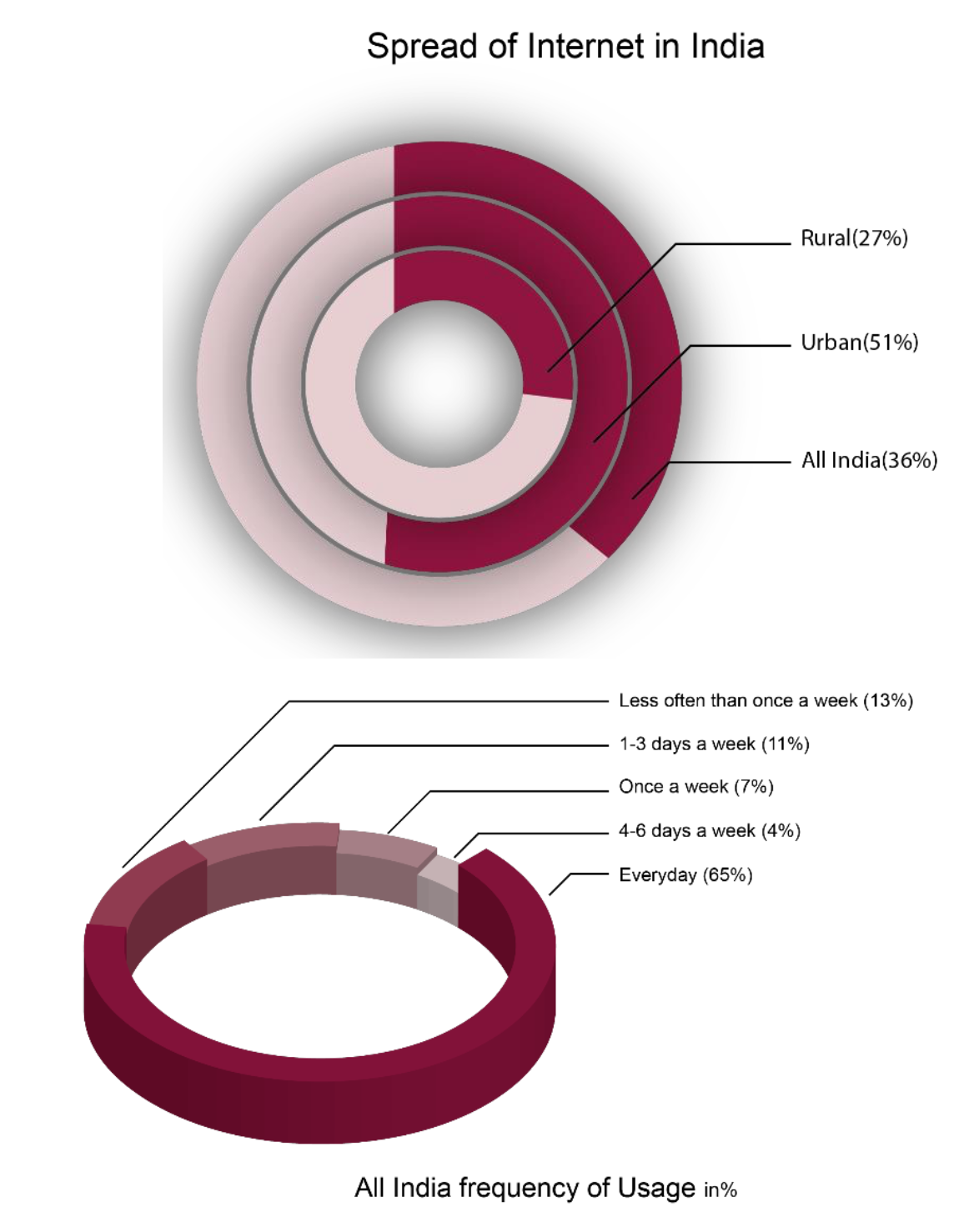
A case study on the spread of the internet in India, as of 2019, India had 415 Mn active internet users above 5 yrs of age. Of the overall internet population, 385 Mn are 12+ yrs old & 66 Mn are 5-11 yrs old who access the internet on family members' devices. Though this number is enormous and India is 2nd leading country with internet users, the distribution in the urban and rural spread of the internet is quite massive. Many improvements have to be made to get rural India under internet connectivity.
Internet usage is more in urban areas than in rural areas, with more connectivity and good network coverage in urban areas. Nearly 2/3rd of the Internet population access the internet daily, and 9 out of 10 users access the internet at least once a week.
The usage pattern divide is seen when we comparatively look at the distribution of usage in urban and rural areas. Most internet users in India access the internet via mobile phones, and the 4G network is the most widespread and majorly used in India. Only 1/3rd of the internet population access internet on the go; particular challenges that rural India faces like connectivity, quality of service, and affordability, if improved, might help increase the use of the internet.
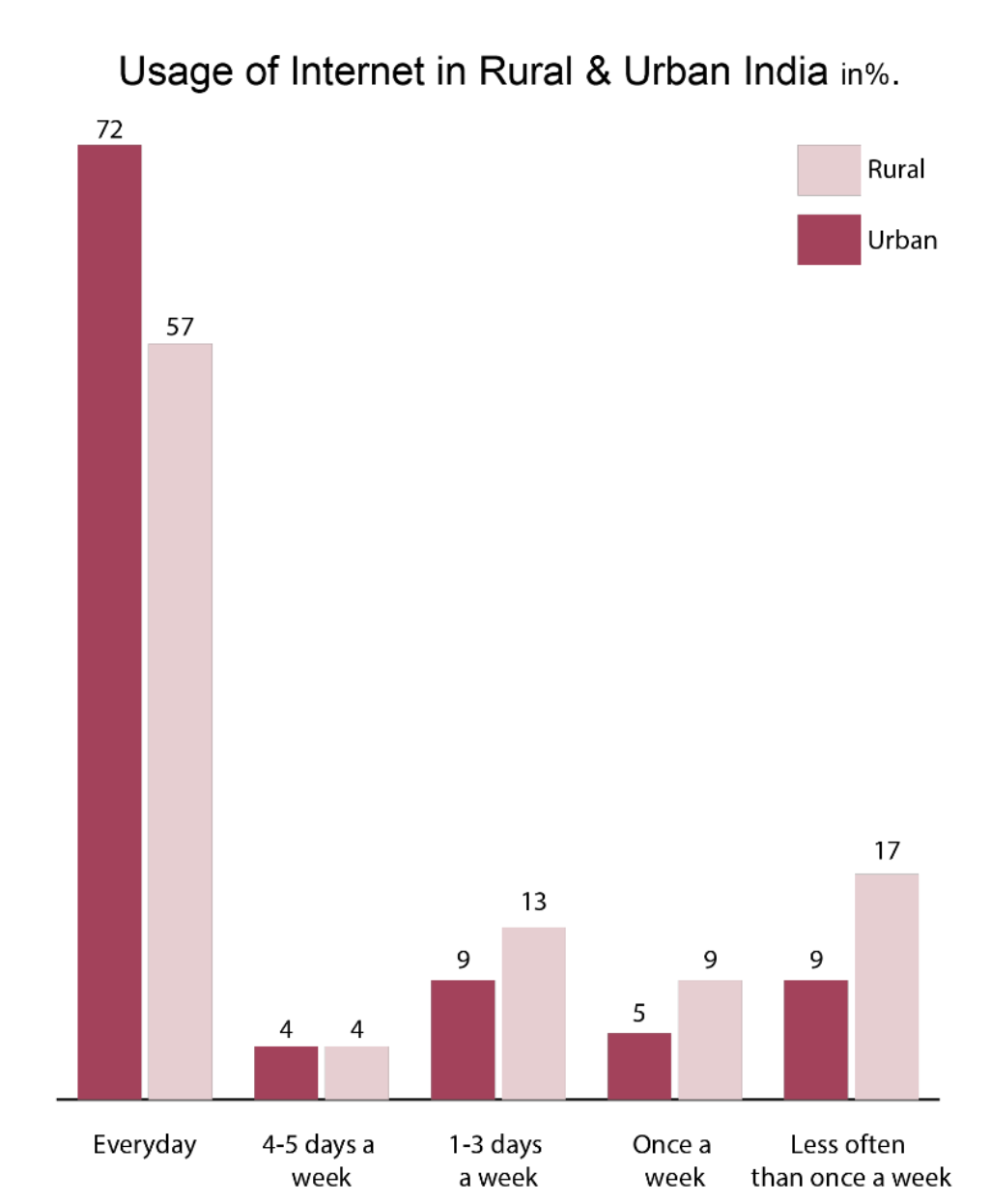
In Australia, the communities are scattered and live in very dynamic landscapes, making it difficult for network providers to provide good network connectivity to the users. This has affected the daily life of many people living in the rural parts of Australia. Many users have to drive close to city/ town areas to access the internet, and even the students cannot carry out their college assignments and research work due to the low bandwidth of the network. Many users have now shifted to satellite connectivity, but the reliability of the internet is still an issue.
With these problems prevailing in the rural areas, the artisans are getting laidback due to the fast-moving world, and they find it hard to catch the speed. Platforms like Etsy are connecting artisans and designers from across the world and boosting their status, but the question arises whether it is the artisan benefiting from this or the channel in between? We even today see intermediaries in trades of these artisans. In Pakistan, women usually are in traditional art forms. But due to cultural hindrances, males are the one who sells these products. Since males are not aware of the process, time, and workload required in making them, there is often a situation when significantly less comes to the pockets of these artisans. NGOs like Happy Returns are working to improve the skills of these artisans and bring them to a recognizable world level. Also, they are trying to improve the conditions of these artisans, considering the cultural and traditional boundaries. However, even though this all is taking place, they find it challenging to market products worldwide, and the involvement of intermediator is seen as an issue by them.
A Kickstarter campaign is reviving ancient Japanese art forms. It started when a swiss filmmaker visited japan to film about Japanese art and introduce it to Europe. But later on, realized that the demand for these products is high, but the availability in Europe is missing. So, he and his motivated team came up with the idea of creating a start-up that will give these traditional artisans a marketplace that will help bridge the gap between the artisan and the client. While creating this start-up, the major hindrance was the language barrier and couldn’t find an artisan family who would support their idea, but later on, managed to gather a few and are now moving ahead. They created a platform named ZenPlus, and with their team, they can communicate in 10 different languages and increase the client base for the artisans.
Today, we find many online marketplaces where many handicraft items are sold and exported. Platforms like Tjori, Ramnarayan blue art pottery, Triveni Chikan arts, Ethnic Kraft, craft India, and many more have a base of particular artisans who work and produce beautiful handicrafts. Also, like e-commerce giants, Flipkart is getting into this with the introduction of 'Samarth,' which aims to bring handicrafts and artisans online. Online programs like Sangam are where the world's handicrafts websites come together, collaborate with designers artisans, and create new, innovative and flamboyant handicrafts.
All these platforms function by hiring artisans or cultures and then developing products. But with the advent of globalization and increasing data flow, there is a need for platforms like ZenPlus to flourish and create an open market for artisans on the same side, which will also help them advance with the modern techniques of the world. This process will help artisans develop skills for their livelihood and update them with the latest trends in the world.
Apart from this, a new type of business opportunity has been known as a social business wherein the NGO or a private company gives shares of a company to artisans who create a sense of ownership for artisans. This makes them work with more honesty and assured income for them. In such a way, artisans get a sense of ownership and work to their best. On the other hand, the NGO or private company creates a value chain needed for maintaining the business running like advertising, the supply chain of products, and more. Examples of such initiatives are Rangsutra and Industry.
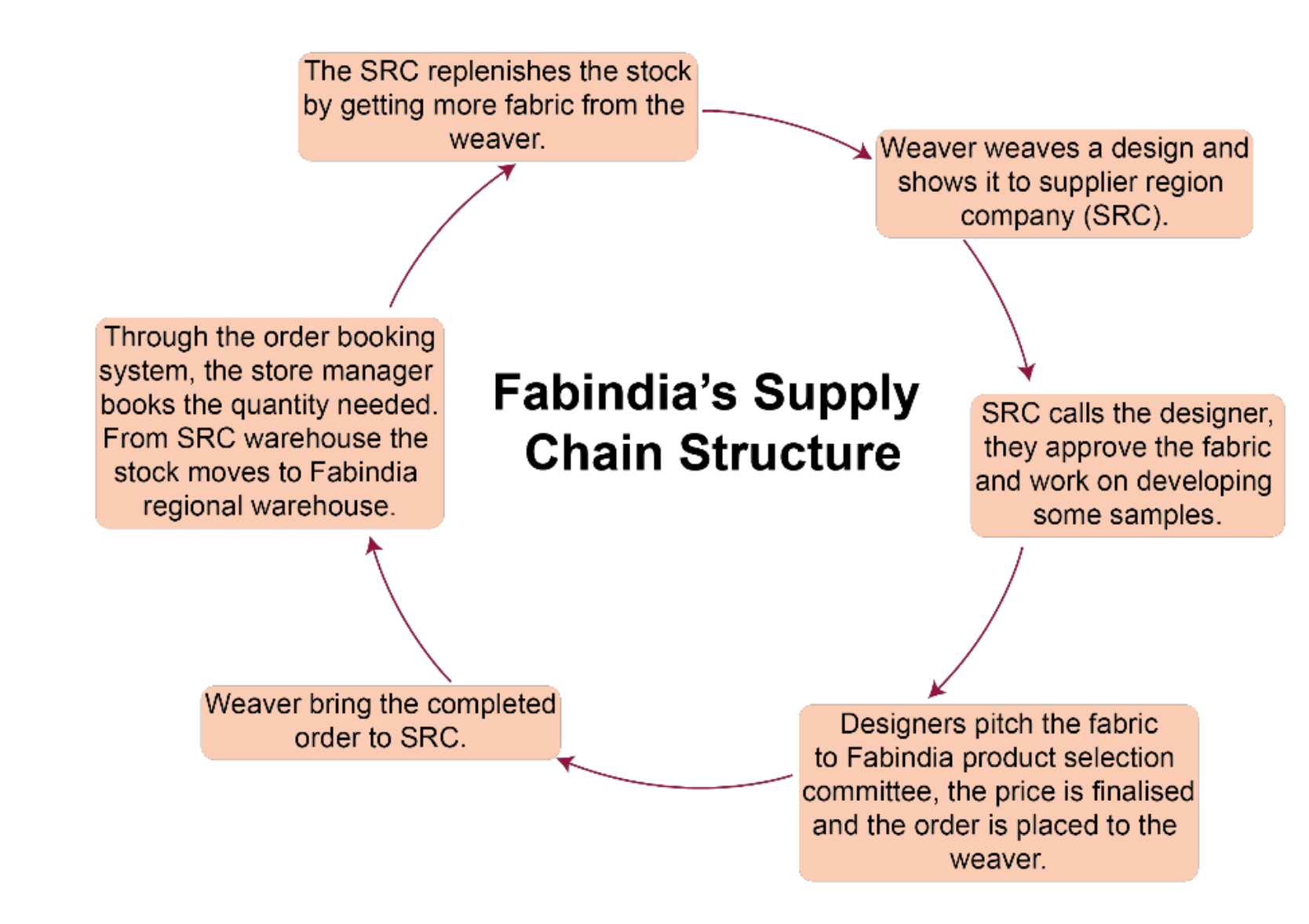
Many good established brands like Fabindia have come a long way in understanding the artisans and creating a business model. Fabindia has been recognized worldwide for a socially responsible business model that links over 80,000 craft producers to the market. This has been possible because of the supply chain management through community-owned companies (COC), which act as intermediaries and are owned by communities. In this model, artisans from a significant part of the stakeholders in the companies.
But despite all these efforts taken artisans' community is still backward.
Qualitative Research
To understand the problem precisely survey was carried out. This survey aimed to get on-ground knowledge of the problems which artisans face. We see a lot of companies and industry giants working to benefit the artisan's community, but very few are seen to create a significant impact and spread across a continent or around the globe. Such surveys help us gain proper knowledge of the situation and widespread offerings by companies.
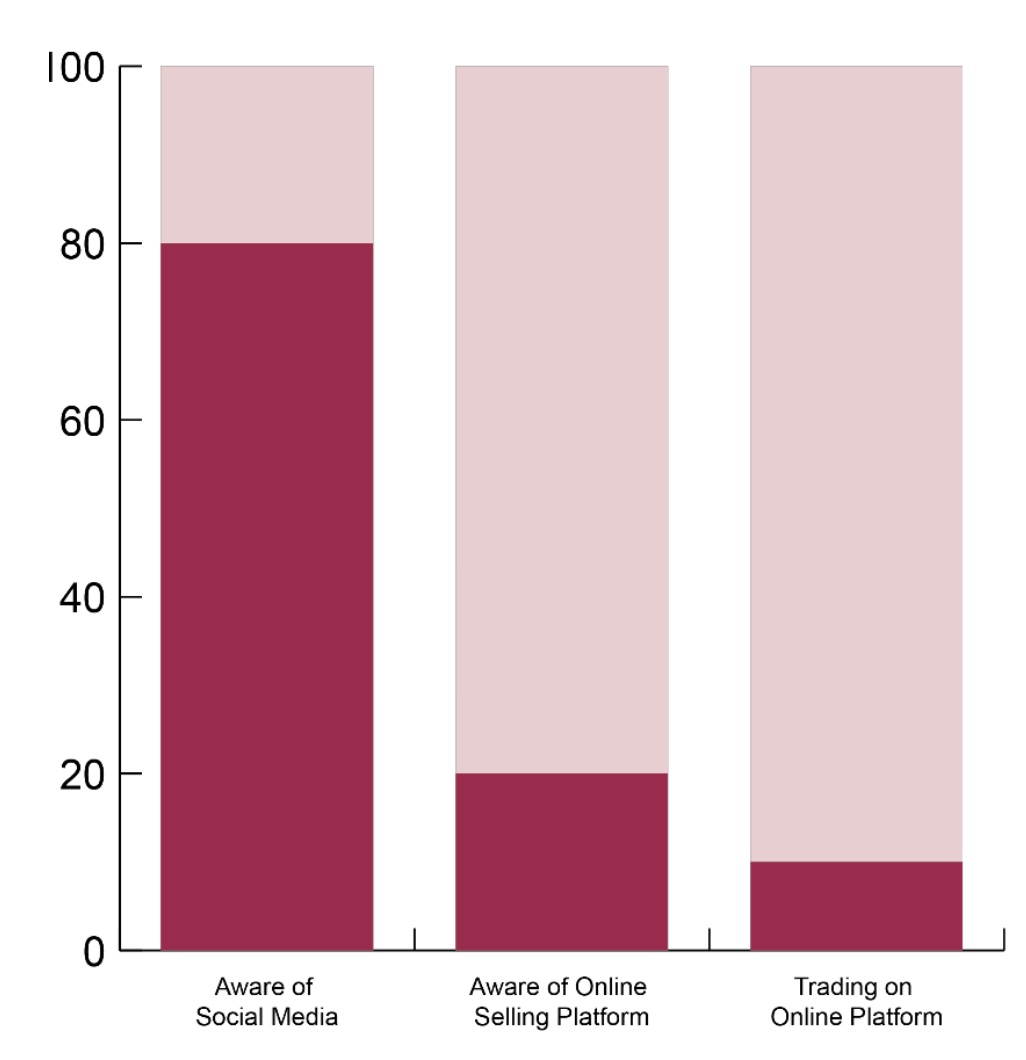
A telephonic survey was conducted across India with artisans from different states. The sample size of artisans was 25. Most of the artisans interviewed were national award winners or merit-listed artisans. These were specifically chosen for the survey since they are pretty well informed about the situation around the world and the trends. The artisans who strive hard under these master craftsmen have limited access to knowledge and trends in the market. The master artisans were interviewed for about 10-15min individually, with questions from various parameters to get them speaking and open to discussion.
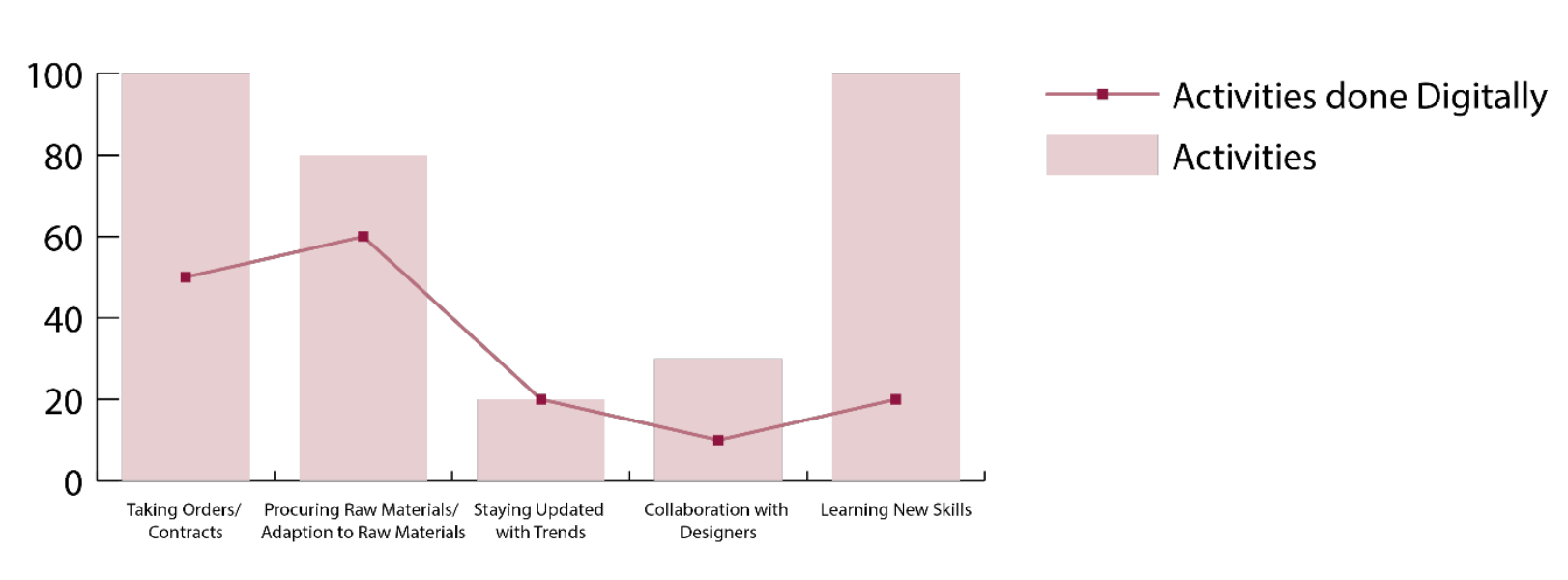
All the artisans have been practicing this art form for more than 20 years. Most of the skill is either a tradition in the family or is acquired. The shift in the art form from later years to current years has been dramatically into how the art form is done. Since today there have been changes in the materials. Artisans have changed from traditional materials to modern materials because of the many advantages modern materials have over traditional materials. With the use of modern materials, they have also adapted to the demands of users and have started producing designs as per the client's requirements. But they are still not aware of the world's trends and demand for handicrafts. Some artisans even export their handicrafts, and the buyers have set up galleries in other countries where these handicrafts are sold. Artisans have varied thoughts regarding the selling price of their products, and some demand higher prices to pay than the current amount they receive.
Specific questions were focused on this aspect to learn about the adaption of the International System of units in their work. Artisans are well adapted to the units used worldwide and comfortably work with these. Apart from adopting units, quite a few have moved to use modern methods for producing their paints or specific activities in producing art forms. E.g., if we look at the Shekhawati painting artists of Rajasthan, they still use the old methods for producing natural paints. For which leaves, flowers have to be churned in a pot with continuous rubbing between two stones. But on the same side, they have started to paint on cement walls as the material industry advanced and more long-lasting building materials were invented. They have also started to use pre-manufactured paints from different companies to make a long-lasting wall painting.
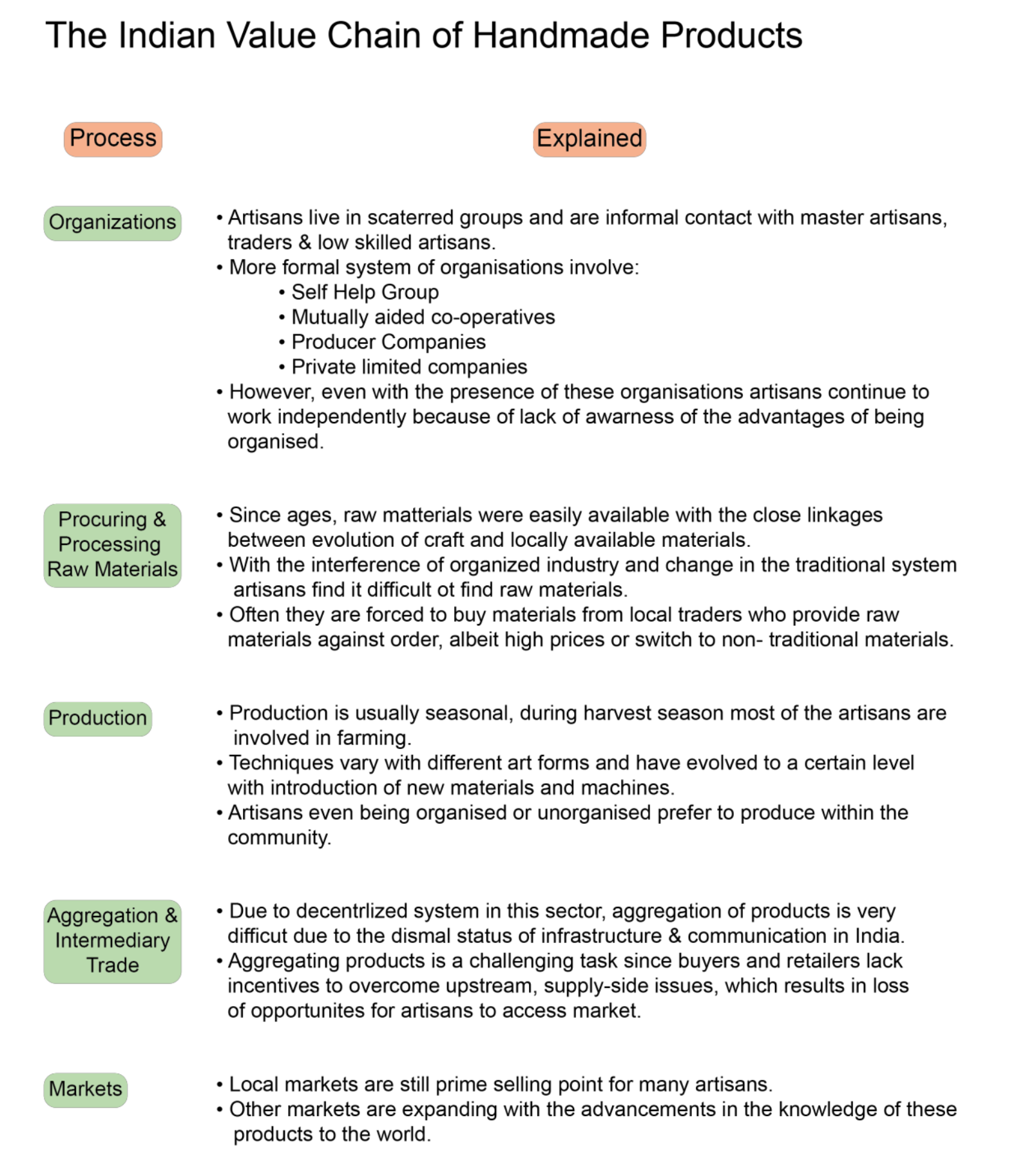
Many artisans are currently using the What’s app for receiving orders and managing their clients. Most of the WhatsApp parts are handled by their sons or their mentees. Some of the artisans themselves can handle the adaption of these technological solutions, but not all. They are well adapted to understand orders directly on the What’s app and deliver the orders through different courier services. But with exported orders, they rely on an intermediary who delivers them to other countries. Some of them also rely on intermediaries to sell handicrafts in the country. Almost all
artisans are not aware of online selling platforms like Amazon.com,AU, CO, UK, DE, IT, etc, and Etsy.com. They are still not adapted to using online services for taking orders. While talking about this, they often mentioned a large share of profit going to the middleman involved. Artists of wooden lacquerware toys receive a very short share as per the manufacturing cost of the toys. Since they belong to a tiny village, they rely on an intermediary to sell the products in cities, to which they receive a very short share of the amount.
Collaborating with designers to make trendy designs and artifacts is limited to a few clusters. Though many enterprises or small companies who conduct workshops are spread the art forms across the country visit these clusters to make their designs, many college students visit to study their techniques and develop new products. But very few artisans are benefited from this collaboration. Based on their experience gained from these workshops and students’ knowledge, artisans develop their designs, which are appreciated in large numbers.
The value chain of Indian handmade products has many loopholes which can be catered with the introduction of digital methods in the value chain.
A field study was carried out at an art cluster in Odisha, India, in the summer of 2019. The art cluster makes Dhokra artifacts of brass with the 3000-year-old lost wax method. In this study, the activities of the artisan communities were studied.
Artisans in that art clusters were national awardees and had a family tradition of practicing the art form. The lost wax method is an ancient tradition-making artifact with harmful wax mold. Artisans living in that cluster had a significantly worse situation; they used to live in non-permanent homes they were not considered a part of the village and were abandoned from the village community. Still, they manage their livelihood in these conditions with this tradition and farming. The connection of these artisans with the outside world was minimal, and only the people who visited this cluster knew about them. Because of awards won at a national level, these artisans were called to exhibitions across India to showcase their work.
Artisans in this cluster used the What's app to communicate with their clients. The raw materials needed were either available in the forest or were bought from the nearby town at a marginally higher cost. The return they get on selling the artifact is low since they don't have a market connection. The clients of these artisans used to send designs through the What's app, communication was usually in Hindi, but few of them used English as their mode of communication, which was clarified by referring to a dictionary. Apart from postal service, these artisans didn't have other delivery services.
Considering the knowledge of online platforms like Amazon or Flipkart, they were aware of these platforms, but they couldn't use them with the unavailability of services.
Research Analysis
A country's growth relies on four central pillars: human resources, physical capital, natural resources, and technology. Artisans living in rural areas had ample human resources and natural resources, but the physical capital and technology were restricted before globalization. With globalization moving to a new level in this decade, we see that artisans' human resources before globalization have been declined since many prefer to work in cities to earn a better living. But today, we see there has been significant growth in the demand for handmade products. With the change in consumer buying behavior, the artisan's cluster has to be boosted to serve a more extensive customer base and help boost the country's economy.
With the continuous expansion in the internet spread across countries, there is hope in increasing the internet population in the coming years. The new and increased knowledge and its spread and expand opportunities for the businesses. For artisans and the handmade industry availability of the internet will be a boon for business and expansion in the production of handicrafts. This will make future generations work in the same field and continue spreading traditional art forms. Internet will open new grounds for the spread of knowledge, new methods of manufacturability, a collaboration between designers and artisans, educating the artisans, and more.
Social businesses will get a new edge with the use of technology. An initiative of tata trust Okhai is similarly helping artisans. They use technology and digital connection to enhance the spread of the products apparel which the artisans
manufacture. They are using social media to spread the knowledge of their initiatives, products, and the promotion of handmade products. The artisans working in this social business are making products and apparel with the latest trends since they are connected with the world. Such initiatives are emerging worldwide and are boosting the artisan's status and knowledge.
Despite these efforts, additional efforts are needed to tackle significant challenges like the language barrier, trust in online business, openness to accept new minds, acceptance of new materials and techniques, advancement in the production methods, combining different art forms, and more. With the increase in internet connectivity, there are high chances that this bridge in the gap is possible. We can even see this in the advancement in taking orders/ contracts of the artisans, as they have adapted to taking orders/ contracts on what's app. One more benefit of this is seen in social business as the artisans accept the change and improve.
Improving the supply chain is much needed in this sector since this is one of the primary reasons NGOs fail. Supply chain improvement is seen in newly established brands like Fabindia, who have learned through their experience and balance both sides of the business (artisans & the brand). We need more such initiatives in this domain. Also, collaboration can be seen to improve the supply chain. Multiple social businesses, start-ups, or private companies can collaborate and improve sustainability and the supply chain. Mutually aided co-operatives where the government has a share can too come into play by initiating the collaborative methods and contributing to the supply chain.
Artisans have the habit of working in their community. There are specific examples where artisans have been given an organized place to work but still preferred to work in their community. Also, the production of handmade products is seasonal as most of the artisans work as farmers during harvest seasons. This makes the production of handmade products limited to time and number, which adds one more barrier to the limited supply of products as these products take much time to make. This shift in work with the time is because some art forms require specific conditions to be made in, and some artisans do farming as a secondary source of income. This has been in practice by artisans for a long and is hard to change, but not impossible. With new techniques and processes, products could be made faster and in any environment.
With the spread of the internet in progress, we can educate artisans digitally with some online classes and enhance their knowledge. Also, showing them new ways of doing business can be done digitally. The bridge of the language barrier is massive and needs to be given the utmost attention for making artisans work comfortably. With tech giants like Google introducing different languages in their software, it can be integrated to teach them and make them or the designer acquainted with a specific language. This language barrier also causes a restriction in the selling of products to international and national customers for the artisans. Hence, the market linkages of these artisans have to rely on the intermediary, making less profit for the artisans. This issue has been in the segment for a very long time. To shed some more light on the issues mentioned above, some proposals have been mentioned in the conclusion.
Bibliography
Questionnaire
- What is your name?
- Which art are you practicing?
- Since how long have you been practicing this art?
- What difficulties do you face today while maintaining the art form?
- How do you procure raw materials?
- What difficulties do you face in procuring raw materials?
- Do you still use traditional methods for making handicrafts?
- What all modern techniques have you started to use?
- How fast were you able to get used to modern techniques?
- What measuring units do you use currently?
- Do you face issues with the measuring units of your clients and the traditional measuring units
- you use?
- How do you manage your clients?
- How often do you receive orders from clients?
- What is the average time you take to produce the complete order?
- Do you have outside India clients? How do you deal with them?
- Do you have any trader or person who manages your business?
- Are you aware of the demand for handicraft products?
- Do you think the share you receive for your prices is fair?
- How much percent do you think you should receive over your products?
- How well are you with handling mobile devices?
- Do you use the app and other social media platforms to take orders?
- How do you utilize these platforms?
- Are you aware of platforms like Amazon, Flipkart, and Etsy?
- Do you use these for taking orders?
- Have you collaborated with designers to make products?
- Are you able to easily understand their thoughts and the medium of conversation?
Recommended








